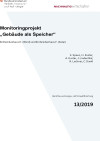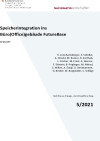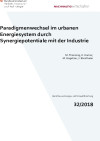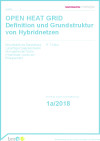Suchergebnisse für "Factsheet: Energietechnologien gestalten, die für alle sinnvoll und nutzbar sind"
Monitoringprojekt „Gebäude als Speicher“. Einfamilienhaus H. (Wind) und Einfamilienhaus F. (Solar)

Monitoring und Vergleich der Leistungsfähigkeit der Thermischen Bauteilaktivierung in zwei bauähnlichen, bewohnten Einfamilienhäusern mit unterschiedlichen Energiequellen (Windstrom bzw. Solarenergie). Zentrales Anliegen ist es, die Funktionalität der Energieversorgung durch Wind- bzw. Photovoltaikstrom in Verbindung mit einem thermischen Speicher zu untersuchen. Die Ergebnisse liefern Erkenntnisse hinsichtlich Berechnungsannahmen, Anlagensteuerung sowie Umsetzbarkeit eines Smart-Grids.
Schriftenreihe
13/2019
S. Spaun, H. Kuster, A. Kuster, J. Lindenthal, R. Lechner, C. Dankl
Herausgeber: BMVIT
Deutsch, 53 Seiten
Downloads zur Publikation
solSPONGEhigh - Hohe solare Deckungsgrade durch thermisch aktivierte Bauteile im urbanen Umfeld
Im Forschungsprojekt solSPONGEhigh wurde die intensive Nutzung von thermisch aktivierten Bauteilen (TABs) als zusätzlicher thermischer Speicher in verschiedenen Gebäuden unter vorrangigem Einsatz von Solartechnologien (Solarthermie bzw. Photovoltaik) untersucht. Die Arbeitshypothese ging davon aus, dass durch die Aktivierung und Nutzung der bauteilimmanenten thermischen Speicher eine Deckung des Gebäudeenergiebedarfs mit Solartechnologien von bis zu 100 % erreicht werden könnte.
SPIN.OFF - SPeicherINtegration in das Büro(OFFice)gebäude Tech2Base
Im vorliegenden Projektvorhaben wurde in ein - in Planung befindliches - Bürogebäude ein Zink-Bromid Redox Flow Batteriespeicher integriert. Anhand dieser Demonstrationsanlage können Fragen, die bei der Integration und dem Betrieb von Batteriespeichern in gewerblichen oder öffentlichen Gebäuden auftreten, beantwortet werden. Neben der optimalen Dimensionierung des Batteriespeichers und der Entwicklung eines selbstlernenden Energiemanagementsystems zur Erhöhung des Eigenverbrauchs und der Minimierung von Lastspitzen wurden auch planungs- und sicherheitstechnische Aspekte untersucht.
OPEN HEAT GRID - Offene Wärmenetze in urbanen Hybridsystemen
Primäres Forschungsthema von OPEN HEAT GRID war die Untersuchung der Möglichkeiten zur Forcierung der Einspeisung industrieller Abwärme in bestehende Fernwärmenetze. Die Projektergebnisse zeigen, dass Abwärme nicht kostenlos ist: trotz minimaler variabler Kosten müssen sich die Investitionskosten in üblichen Amortisationszeiten rechnen. Die Analyse zeigt, dass es keiner staatlichen Regelung im Sinne einer Einspeiseverpflichtung oder Marktliberalisierung bedarf. Jedoch liegen aus ökonomischer Sicht Informationsasymmetrien vor, wodurch es möglich ist, dass rationale Entscheidungen nicht zustande kommen.
solSPONGEhigh - Hohe solare Deckungsgrade durch thermisch aktivierte Bauteile im urbanen Umfeld

Im Forschungsprojekt solSPONGEhigh wurde die intensive Nutzung von thermisch aktivierten Bauteilen (TABs) als zusätzlicher thermischer Speicher in verschiedenen Gebäuden unter vorrangigem Einsatz von Solartechnologien untersucht. Die Arbeitshypothese ging davon aus, dass durch die Aktivierung und Nutzung der bauteilimmanenten thermischen Speicher eine Deckung des Gebäudeenergiebedarfs mit Solartechnologien von bis zu 100 % erreicht werden könnte.
Schriftenreihe
20/2018
Heimrath, Lerch, Ramschak, Mach, Fink
Herausgeber: BMVIT
Deutsch, 112 Seiten
Downloads zur Publikation
Speicherintegration ins Büro(Office)gebäude FutureBase (SPIN.OFF)

Im vorliegenden Projektvorhaben wurde in ein - in Planung befindliches - Bürogebäude ein Zink-Bromid Redox Flow Batteriespeicher integriert. Anhand dieser Demonstrationsanlage können Fragen, die bei der Integration und dem Betrieb von Batteriespeichern in gewerblichen oder öffentlichen Gebäuden auftreten, beantwortet werden.
Schriftenreihe
5/2021
K. Leonhartsberger, S. Schidler, A. Hirschl, M. Rosner, R. Korthals, L. Fischer, M. Ernst, A. Werner, F. Ettwein, B. Priglinger, M. Meisel, S. Wilker, A. Estaji, O. Stelzhammer, G. Becker, W. Burgstaller, S. Schlägl
Herausgeber: BMK
Deutsch, 139 Seiten
Downloads zur Publikation
PESI - Paradigmenwechsel im urbanen Energiesystem durch Synergiepotentiale mit der Industrie

Analyse der Nutzungsmöglichkeiten industrieller Überschussenergien verschiedener Form (Abwärme, Abwasser, Abfall) sowie regenerativer Energieträger im industriellen Bereich (Solaranlagen auf Dachflächen) in angrenzenden urbanen Gebieten, die als Energieschwamm fungieren. Auf Basis realer Verbrauchs- und Verfügbarkeitsdaten wurde ein Simulationsmodell erstellt und Möglichkeiten zu Synergien dokumentiert.
Schriftenreihe
32/2018
M. Theissing, K. Karner, M. Rogetzer, J. Bärnthaler
Herausgeber: BMVIT
Deutsch, 69 Seiten
Downloads zur Publikation
OPEN HEAT GRID - Offene Wärmenetze in urbanen Hybridsystemen

Primäres Forschungsthema von OPEN HEAT GRID war die Untersuchung der Möglichkeiten zur Forcierung der Einspeisung industrieller Abwärme in bestehende Fernwärmenetze.
Schriftenreihe
1/2018
Herausgeber: BMVIT
Deutsch
Downloads zur Publikation
LTS Flywheel - Long Term Storage-Flywheel: New approaches for increasing the economically usable storage time and safety
Development of the fundamentals for a Long Term Storage (LTS)-flywheel for decentralized storage of electrical energy (e.g. from wind or PV power plants), with a significant increase in storage time (goal: 12 hours) and safety, featuring low system costs. Therefore, the LTS-Flywheel is an essential contribution to the building of the future.
Symbiose-4-I&C - Optimal decentralized hybrid storage technologies among different energy systems -4-Industry and Commerce
The project Symbiose-4-I&C analysed the coupling of existing energy networks/-carriers, established on centralized energy network nodes or directly next to a consumer (households, industry and commerce) and the benefits of applying decentralized storage technologies. The optimal position, dimension and the right storage and conversion technology and an optimal energy wide operation of larger consumer groups were estimated for an urban model region.
StromBIZ - demonstration projects: business models for decentralized electricity generation and distribution
Feasible business models to utilize locally generated renewable energy are expected to induce a tipping point for the "Energy Turnaround" in Austria. Within the proposed project a number of demonstration PV plants on residential and non-residential buildings had been realized. On this basis new approaches of business cases had been developed, implemented, tested and disseminated.
solSPONGEhigh - High solar fraction by thermally activated components in an urban environment
Within this project the intensive use of thermally activated building elements (TABs) as an additional thermal storage in different buildings, with solar technologies (thermal, PV) preferred for energy supply, was investigated. The aim was to activate and use the thermal storage potential that is immanent in the building elements and thereby achieve solar coverage of the building's heat demand of nearly 100 %.
AR-HES-B – Energy storage, production and recovery of valuable substances in wastewater treatment plants
AR-HES-B develops technologically based concepts of municipal wastewater treatment plants in order to convert them from energy consumers into a hybrid energy provider, energy storage and a provider of resources. The concept enables wastewater plants to turn into an important platform in the regional energy and mass transfer.
OPEN HEAT GRID - Open Heat Grids in urban hybrid systems
The primary research topic of OPEN HEAT GRID was to investigate the possibilities of enforcing the feed-in of industrial waste heat into existing district heating networks. The project results show that excess heat is not for free: despite minimal variable costs, the investment costs need to satisfy usual payback periods. The analysis shows that there is no need for a regulation in the sense of a feed-in obligation or market liberalization. However, from an economic point of view, information asymmetries exist, which may lead to irrational decisions.
urban pv+geotherm - Innovative concepts for the supply of large volume buildings/ quarters with PV and geothermal energy
The use of renewable energies in inner city locations is mostly linked to higher costs andconsidered as problematic. The aim of this project was to optimize (cost and energy) heating (and where required, cooling) using geothermic and photovoltaic for an urban, densely-built development area. With the project´s findings it will be easier to ecologically and economically plan the use of renewable energies especially in urban areas.
Using buildings as energy storage - Monitoring project: Detached house H and detached house F Energy source wind power – Energy source solar power
Monitoring and comparison of performance of thermally activated building components in two similarly built, inhabited detached houses with different energy sources (wind and solar power). The functionality of energy supply through wind power or solar energy will be investigated as well as the verification of the practicability of self-regulating system control due to building temperature behaviour. The results provide an insight into the calculation assumptions, system control and feasibility of the smart grid technology.
Manage_GeoCity - Development of a method for the coordinated management of geothermal energy in urban areas
Based on the urban region Graz a method had been developed for the coordinated use and management of shallow geothermal energy for heating and cooling as well as seasonal heat storage in urban regions. Ground water flow, different geologic conditions, heating and cooling demand, heat input from solar collectors and industrial waste heat and the possibilities of seasonal heat storage in the subsurface were considered.
TFlex - Temperature-flexibilisation in low-load operation of local district heating systems
Within the research project TFlex it was checked if the losses adherent to small district heating networks during low-load periods can be reduced. One possible solution is by deactivating the network and supplying the customers from previously charged decentralized storages. The optimal clustering of the storages and the possibility of solar-charging the storage were calculated with the aim of a guaranteed one-hundred percent heat supply.
CiQuSo - City Quarters with optimised solar hybrid heating and cooling systems
The project CiQuSo aimed to develop, evaluate and optimize concepts for solar energy systems to provide energy for buildings and cities. The applicability of the developed methods and concepts were shown as an example at Itzling, a part of Salzburg city.
SMARTIES - SMART Innovative Energy Services - Analysis of requirements of smart energy-services
The emerging development of smart grids provides market opportunities for new ICT-based services ("smart value-added services"). Economic and organizational barriers are foreseeable that could affect the establishment of business models and service providers (data formats, connectivity, controllability, etc.). In order to improve the chances especially for new and local actors, SMARTIES proactively tries to eliminate hindrances of innovation.
